NEFAR Launch, February 11, 2006
Jimmy's Most Excellent CATO
A dramatic stroke of good luck
I've rebuilt the forward section of the Sugar Rush to accommodate my
paper nose cone with altimeter.
It's a bit longer now, and two
pairs of wires run down to the lower end of the body tube to
effect ejection. I am using the redundant apogee mode with two
different e-matches in the ejection powder. This rocket is not
quite ready for dual deployment, so I might as well have as much
redundancy as possible. As if that would matter....
It is still rather pink. That will matter.
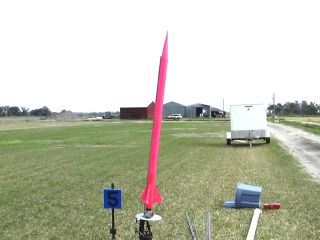
Video - short flight ending in CATO.
4 meg .wmv file, 19 seconds of video
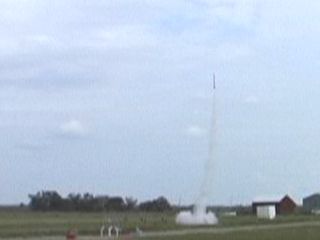
At 0.7 seconds into the flight and about 70 feet up there was a "pop" and no more thrusty sound.
It wasn't very loud, but definitely not a good sign.
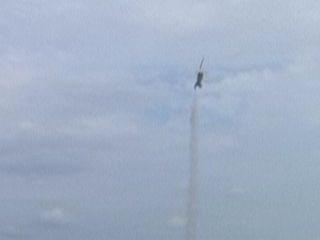
The forward section coasted on to maybe 200 feet.
Aft section came down in a rain of parts.
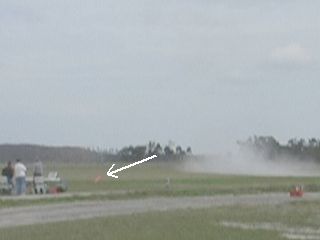
Forward section landed flat, about 100 feet from launch control table. Here it is on the first bounce.
Aft section debris field was about where the smoke is now.
Here are the aft parts I gathered up, reassembled for this photo the following day.
They were easy to find.

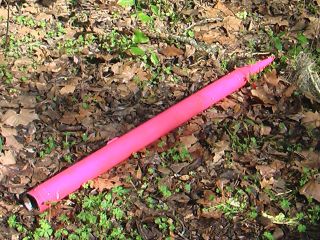
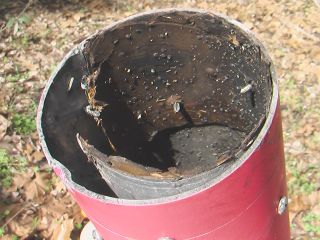
Forward section is in good shape, except for a few inches
toward the aft end. There, the tube has one short crack and a few
dings,
but once the remnants of the fin section were removed, there is little
heat damage. In the video one can see a smoke trail emerging from
this upper tube - it looks like it has a piece of propellant burning
inside it. But apparently not, as there is no evidence of
excessive heat. Even the parachute has no holes or scorch-marks.
Perhaps the trail was residual smoke, or a piece of propellant
following the airframe upward.
The forward motor closure was found lying right beside the upper
section
of airframe. I am guessing that it rode along in the parachute
and bounced out when the tube hit the ground.. The fact that the
upper section is not
gutted indicates that the forward closure let go rather gently.
But
the pressure of the motor was released inside the aft section, and it
blew
apart at the seams. All 3 fins came off, and the aft section was
divided
into 3 pieces, one slice at each fin slot.
The motor has been modified substantially. The forward closure has left
it, flaring the casing beyond the snap ring groove. You can
almost make out in the photos that the forward end is belled a little
to an inch or so down from the end, to about where the head-end closure
would have reached. Inside measurement at the belled section is
1.968 inches (widest spot) where before the launch it was1.939 inches.
The forward end is flared so much that the slimline retainer won't come off!
Not until I cut the tube so I'm gonna wait on that one until there
is a need.
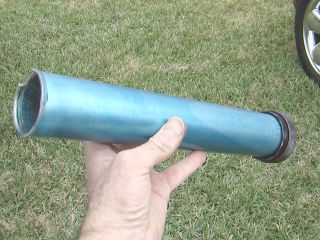
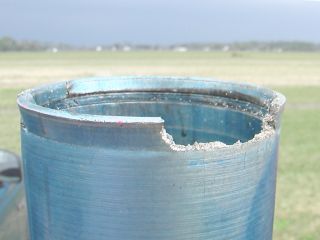
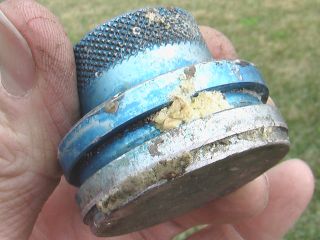
Forward closure had some little chunks of propellant in the
O-ring groove. That cruddy stuff at the base is also
propellant with dirt on it. Funny.... Looks like the propellant left in
a big hurry. The propellant glob is in the middle of the spot where
the snap-ring gap would have been. Note the two little gouges on
either side - they are spaced exactly where the snap ring bosses and
holes would have been. Also note the gap on the casing, the
part that is broken away - The biggest bulge in the tube is exactly
opposite that gap. So I believe the snap ring deformed upwards
and released the head plug on one side but the snap-ring lugs held on,
forcing the plug to angle up to get out. At some point the O-ring
left, the case started venting forward, the contents of
the motor casing blew by, and some stuck there on the head-end plug.
Cause?
At first I wondered if the head-end had suffered a fatigue failure. Then I looked at the nozzle.
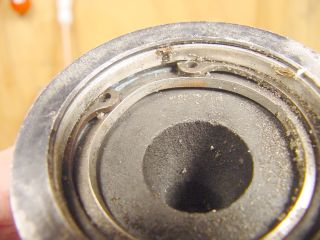
(click on photo for larger image)
That nozzle-support ring was flat when I put it in. It
sure isn't
flat now! Serious overpressure, I would say. I am
astonished
that the nozzle didn't crumble, but it is mostly intact. Big
flakes fell off the sides when I removed it, and lots of chips around
the lower
edge, where it conformed to the angle of the ring that is badly bent.
Why? I have fired this motor with grains that developed twice the pressure
this one should have. My first guess is inhibitor failure, as I was
using a different epoxy than usual to get the propellant to stick. Also,
there was a novel smoke grain embedded in the propellant grain, which might
have compromised the inhibitor somehow, or caused the grain to crack under
pressure. Thirdly, this propellant is less dense than other batches
I have been making, and burns more quickly than most. Air inclusion
is suspected. But it seems unlikely that this would have caused such
radical overpressure, as the burn rate of the propellant at 1 atm is 8 seconds
per linear inch, well within normal limits for catalyzed propellant such
as I have used in this motor several times. Further tests are needed
to determine the most likely cause of failure. (Darn! I have
to do more static tests! : )
Hey, wait.... I think I've figured it out. Perhaps it is the results
of yesterday's bright idea. Sometimes the difference between "brilliant"
and "stupid" is not readily apparent to me.
The Mistake
Wanting to use the full grain size for thrust, but also wanting a long smoke
afterward, I made some nozzleless end-burner motors stuffed with catalyzed
rcandy. They are 3.5 inches long, 0.5 inch inside diameter, and made
from three thicknesses of posterboard. I epoxied the inside, filled
them with propellant all but for the last 1/4 inch, and filled the end with
remaining epoxy. The far end was left open, so the propellant could
ignite from that end.
After cooling and hardening, I epoxied them into the casting/inhibitor tube.
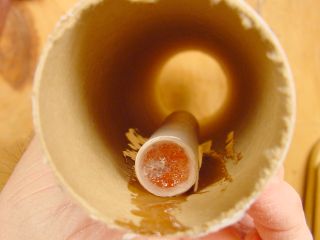
After that epoxy hardened, the casting
tube was coated with West Systems epoxy on the inside, taking care to coat
the smoke grain too, on all sides except the face to be ignited. Warm propellant
was packed into the tube, and a coring rod driven in opposite the smoke grain.
The whole thing was allowed to cool and harden overnight.
The idea is that the smoke grain would be protected from the flame of combustion
by the propellant itself, but would be gradually revealed and continue to
burn for 20 seconds or so after the propellant burned out. At least
that was the idea....
The video shows that the CATO occurred 0.7 seconds into the burn. That
would be just about the time the flame front reached the edge of the smoke
grain. So I'm thinking it got blasted loose and clogged the nozzle.
The epoxy is strong, but it is stuck to cardboard, which is not very strong.
It is not difficult to imagine a clogged nozzle causing the damage that was observed.
It is difficult imagining any of the other options causing such a dramatic
overpressure. So the propellant's off the hook, and the epoxy is probably good. Pending further testing, of course.
OK, so how can I possibly construe this CATO as a GOOD thing?
No doubt you have already realized that I am a
pathological optimist, bordering upon the delusional.
That is good. The more things I like, the happier I'll be.
But an embarrassing CATO in front of a crowd? My favorite motor
casing destroyed? A badly damaged airframe? A failed opportunity to
test my new nose cone? A lost snap ring? To be happy about that would be a stretch, even for me.
But this CATO saved the rocket from an fate even worse than a fate worse than death.
Upon recovery, the forward section seemed in good shape.
The nose wasn't even dirty. But the
altimeter didn't sing. It did not beep. Even when turned
off and on a couple of times it did not respond. So I thought it
had bumped it's head, and took it home and put it on a pillow to
recover.
Next day, I opened it up.
Here's how it was before the flight.
What's wrong with this picture?
Extra points to anyone who sees my goof already:
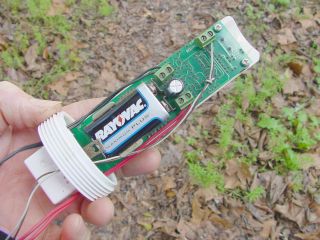
After the flight, it looked like this.
Notice any difference?
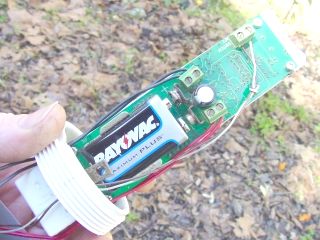
How about a closeup:
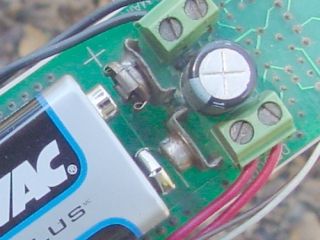
Acceleration unplugged the battery sometime during it's brief flight.
Two wrongs don't make a right, but three lefts do.
You don't have to be stupid to do dumb things.
I have derided a number of
novice rocketeers for failing to secure their batteries.
Now my words come back to haunt me. Not that I should abstain from
warning others, but that I would fail to heed my own warnings.
Oh, well. If that's the worst mistake I made that day, then it was better than average.
And I can simply turn the altimeter around for the next flight.
Or secure the battery better. Perhaps to
have it completely separated from the circuit board, so that the little
board does not have to support the heavy battery under acceleration.
Good fortune
If the CATO had not occurred, the rocket would have
gone to four thousand feet or so, and come down ballistic, destroying itself and causing great
damage to
whatever it hit. Hopefully, it would have just made a pink hole in sod - I am careful to
aim my rockets away from the spectator
area just in case. But that
is no guarantee of safety, especially on such a windy day.
Chances are, only the motor casing would have survived such a
crash. So this brave casing gave its life to save the nose cone,
the altimeter, and the new forward section. The fin department
was
wasted, but the fins themselves are OK and the motor
retainer is intact. I need to rebuild that section to accommodate a
longer motor
anyway. Parts are ordered...
Lessons Learned:
1. Static test before flight test. Even when the motor
changes seem trivial, there can be significant unintended effects.
2. Test one new thing at a time. New KNO3, new epoxy, new
grain configuration, new nose cone, new forward section, new
orientation for the altimeter.... what was I thinking?
3. Hmmm.... what was number 3.... Guess I should review my notes. Is 66.667 a passing score?
As fine as that was, turns out I did not win the CATO contest today.
Steve Pollock, J350 flight
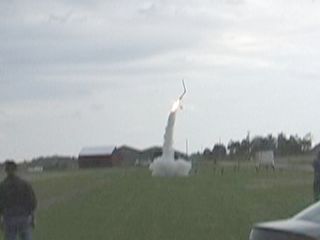
Click here for video of this flight
4 meg .wmv file, 22 seconds of video
Consensus at the launch was that case liner failure led to overheating
of the motor tube. I found the head end of the tube after
everyone had left. Click Here for some pictures of it.
Jimmy Yawn
2/12/06
rev. 2/26/06
jyawn@sfcc.net















